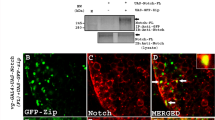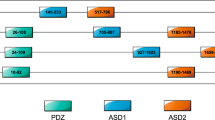Abstract
-
1.
A previous study implies that diacylglycerols (DAGs) released by the phototransduction cascade in photoreceptors of a crab, Leptograpsus, activate protein kinase Cs (PKCs). PKCs were suggested to phosphorylate nuclear proteins that regulate the transcription of rhabdomeral membrane precursors.
-
2.
We show that a transcription inhibitor, actinomycin D, reduces the rhabdomeral renewal induced by a diacylglycerol lipase inhibitor, U-57908, but does not eliminate it.
-
3.
Within the particular experimental protocol, rhabdomeral maintenance and renewal by controls are inhibited by actinomycin D in an absence of U-57908.
-
4.
We conclude that although rhabdomeral renewal induced by PKC activation involves the regulation of transcription, multiple pathways are implicated.
-
5.
An alternative route for the degradation of DAGs by phosphorylation is eliminated because a specific inhibitor of DAG kinases, R-59022, exerts no effect.
-
6.
U-57908 promotes photoreceptor shrinkage which is not compromised by actinomycin D. Shrinkage occurs independently of rhabdomeral renewal, suggesting a further consequence of PKC activation.
Similar content being viewed by others
Abbreviations
- DAG:
-
diacylglycerol
- OKA:
-
okadaic acid
- PKC:
-
protein kinase Cs
References
Arikawa K, Kawamata K, Suzuki T, Eguchi E (1987) Daily changes of structure, function and rhodopsin content in the compound eye of the crab Hemigrapsus sanguineus. J Comp Physiol A 161:161–174
Blest AD (1988) The turnover of phototransductive membranes by compound eyes and ocelli. Adv Insect Physiol 20:1–53
Blest AD, Stowe S (1990) Dynamic microvillar cytoskeletons in arthropod and squid photoreceptors. Cell Motil Cytoskel 17:1–5
Blest AD, Stowe S, de Couet HG (1984) Membrane turnover in the photoreceptors of arthropods. Sci Prog Oxford 69:83–100
Blest AD, Carter M, Clausen JA, Stowe S, Trowell SC, Tsukitani Y (1991) Induction of retinal degeneration in a crab by light and okadaic acid in vitro: Comparison with the Drosophila light-dependent retinal degeneration mutant w rdgB KS222. Visual Neurosci 7:35–48
Blest AD, Stowe S, Carter M, Tsukitani Y (1992 a) Manipulation of phototransductive membrane turnover by crab photoreceptors in vitro: effects of two protein kinase activators, SC-9 and phorbol ester in the presence of a protein phosphatase inhibitor, okadaic acid. J Comp Physiol A 170:189–199
Blest AD, Stowe S, Carter M, O'Gara E, Delaney A (1992b) Light dependent endocytosis of crab rhabdomeral membrane potentiated by okadaic acid is reduced by either of two inhibitors of protein kinase C, or by a Ca2+ channel blocking agent, diltiazem. J Comp Physiol A 171:523–532
Blest AD, Stowe S, Delaney A (1993) Diacylglycerols as putative second messengers that regulate phototransductive membrane turnover by arthropods. Effects of a diacylglycerol lipase inhibitor, U-57908, and of a diacylglycerol on phototransductive membrane turnover by crab photoreceptors in vitro. J Comp Physiol A 173:57–63
Cohen P (1989) The structure and regulation of protein phosphatases. Annu Rev Biochem 58:453–508
De Courcelles Dde-C, Roevens P, Van Belle H (1985) R59022, a diacylgycerol kinase inhibitor. J Biol Chem 260:15762–15770
Divecha N, Banfic H, Irvine RF (1991) The polyphosphoinositide cycle exists in the nuclei of Swiss 3T3 cells under the control of a receptor (for IGF-1) in the plasma membrane, and stimulation of the cycle increases nuclear diacylglycerol and apparently induces translocation of protein kinase C to the nucleus. EMBO J 10:3207–3214
Greenberg ME, Ziff EB, Greene LA (1986) Stimulation of neuronal acetylcholine receptors induces rapid gene transcription. Science 234:80–83
Hardie RC, Peretz A, Suss-Toby E, Rom-Glas A, Bishop SA, Selinger Z, Minke B (1993) Protein kinase C is required for light-adaptation in Drosophila photoreceptors. Nature 363:634–637
Hug H, Sarre TF (1993) Protein kinase C isoenzymes: divergence in signal transduction? Biochem J 291:329–343
Hunter T, Karin M (1992) The regulation of transcription by phosphorylation. Cell 70:375–387
Keller HU, Niggli V, Zimmerman A (1989) Diacylglycerols and PMA induce actin polymerization and shape changes in lymphocytes: relation to fluid pinocytosis and locomotion. J Cell Sci 93:457–465
Lapetina EG, Reep B, Ganong BR, Bell RM (1985) Exogenous sn-1,2-diacylglycerols containing saturated fatty acids function as bioregulators of protein kinase C in human platelets. J Biol Chem 260:1358–1361
Meek DW, Street AJ (1992) Nuclear protein phosphorylation and growth control. Biochem J 287:1–15
Minke B, Selinger Z (1992a) Inositol lipid pathway in fly photoreceptors: excitation, calcium mobilization and retinal degeneration. Prog Retinal Res 11:99–124
Minke B, Selinger Z (1992b) The inositol-lipid pathway is necessary for light excitation in fly photoreceptors. In: Corey D, Roper SD (eds) Sensory transduction. Chapter 12. Rockefeller University Press, New York, pp 201–217
Nishizuka Y (1988) The molecular heterogeneity of protein kinase C and its implications for cellular regulation. Nature 334:661–665
Nishizuka Y (1992) Intracellular signalling by hydrolysis of phospholipids and activation of protein kinase C. Science 258:607–614
Porter JA, Montell C (1993) Distinct roles of the Drosophila ninaC kinase and myosin domains revealed by systematic mutagenesis. J Cell Biol 122:601–622
Porter JA, Hicks JL, Williams DS, Montell C (1992) Differential localizations of a requirement for the two Drosophila ninaC kinase/myosins in photoreceptor cells. J Cell Biol 116:683–693
Sheng M, Greenberg ME (1990) The regulation and function of c-fos and other intermediate early genes in the nervous system. Neuron 4:477–485
Sheng M, McFadden G, Greenberg ME (1990) Membrane depolarization and calcium induce c-fos transciption via phosphorylation of transcription factor CREB. Neuron 4:571–582
Stowe S (1980) Rapid synthesis of photoreceptor membrane and assembly of new microvilli in a crab at dusk. Cell Tissue Res 211:419–440
Stowe S (1981) Effects of illumination changes on rhabdom synthesis in a crab. J Comp Physiol 142:19–25
Stowe S (1982) Rhabdom synthesis in isolated eyestalks and retinae of the crab Leptograpsus variegatus. J Comp Physiol 148:313–321
Stowe S (1983) Light-induced and spontaneous breakdown of the rhabdoms in a crab at dawn: depolarisation versus calcium levels. J Comp Physiol 153:365–375
Van Blitterswijk WJ, Hilkmann H (1993) Rapid attenuation of receptor-induced diacylglycerol and phosphatidic acid by phospholipase D-mediated transphosphatidylation: formation of bisphosphatidic acid. EMBO J 12:2655–2662
White RH (1967a) The effects of light and light-deprivation upon the ultrastructure of the larval mosquito eye. II. The rhabdom. J Exp Zool 166:405–425
White RH (1967b) The effects of light and light-deprivation upon the ultrastructure of the larval mosquito eye. III. Multivesicular bodies and protein uptake. J Exp Zool 169:261–278
White RH, Bennett RR (1992a) Rhabdomeric membrane and smooth endoplasmic reticulum in photoreceptors of Manduca sexta: modulations associated with the diurnal light/dark cycle and effects of chromophore deprivation. Cell Tissue Res 270:57–64
White RH, Bennett RR (1992b) Assembly of rhabdomeric membrane from smooth endoplasmic reticulum can be activated by light in chromophore-deprived photoreceptors of Manduca sexta. Cell Tissue Res 270:65–72
White RH, Lord E (1975) Diminution and enlargement of mosquito rhabdom in light and darkness. J Gen Physiol 65:583–598
White RH, Gifford D, Michaud NA (1980) Turnover of photoreceptor membrane in the larval mosquito ocellus: rhabdomeric coated vesicles and organelles of the vacuolar system. In: Williams TP, Baker BN (eds) The effects of constant light on visual processes. Plenum, New York London, pp 271–296
Williams DS (1982) Ommatidial structure in relation to turnover of photoreceptor membrane in the locust. Cell Tissue Res 225:595–617
Author information
Authors and Affiliations
Rights and permissions
About this article
Cite this article
Blest, A.D., Stowe, S. & Delaney, A. A transcription inhibitor, actinomycin D, partially inhibits the rhabdomeral renewal induced by a diacylglycerol lipase inhibitor, U-57908 in crab retinas. J Comp Physiol A 174, 747–754 (1994). https://doi.org/10.1007/BF00192724
Accepted:
Issue Date:
DOI: https://doi.org/10.1007/BF00192724




